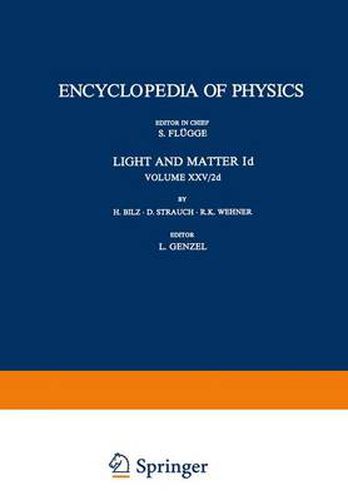Readings Newsletter
Become a Readings Member to make your shopping experience even easier.
Sign in or sign up for free!
You’re not far away from qualifying for FREE standard shipping within Australia
You’ve qualified for FREE standard shipping within Australia
The cart is loading…






This title is printed to order. This book may have been self-published. If so, we cannot guarantee the quality of the content. In the main most books will have gone through the editing process however some may not. We therefore suggest that you be aware of this before ordering this book. If in doubt check either the author or publisher’s details as we are unable to accept any returns unless they are faulty. Please contact us if you have any questions.
The dynamical properties of solids have recently attracted renewed interest in connection with the increasing understanding of phase transitions and re lated phenomena. In particular, soft modes or, more generally, phonon ‘anom alies’ seem to play an important role in structural and electronic phase tran sitions, such as ferroelectric or superconducting transitions. The understanding of the mechanisms responsible for the occurrence of unusually low frequencies in phonon spectra requires a detailed analysis of the microscopic forces governing the lattice vibrations. Of particular importance is the influence of the electron lattice interaction in the adiabatic approximation which in many cases is the origin of peculiarities in the phonon self-energy. In this work the vibrational spectra of pure non-metals and of those con taining point defects are investigated. ‘ In these materials the interrelation be tween the pseudo-harmonic forces (determining the phonon dispersion re lations) and the non-linear anharmonic and electron-phonon forces (as they act in infrared and Raman spectra) is most obvious and can be quantitatively analysed in terms of appropriate models. The main task is to arrive at a physically correct treatment of electronic degrees of freedom, as for example in an electronic 'shell’ model, which leads to the description of phonon spectra in terms of long-range polarizabilities and short-range deformabilities. The pur pose of our review is to stimulate further investigations which, we hope, will result in explicit relations between the parameters of the semi-microscopic models and the matrix elements from the electronic band structure.
$9.00 standard shipping within Australia
FREE standard shipping within Australia for orders over $100.00
Express & International shipping calculated at checkout
This title is printed to order. This book may have been self-published. If so, we cannot guarantee the quality of the content. In the main most books will have gone through the editing process however some may not. We therefore suggest that you be aware of this before ordering this book. If in doubt check either the author or publisher’s details as we are unable to accept any returns unless they are faulty. Please contact us if you have any questions.
The dynamical properties of solids have recently attracted renewed interest in connection with the increasing understanding of phase transitions and re lated phenomena. In particular, soft modes or, more generally, phonon ‘anom alies’ seem to play an important role in structural and electronic phase tran sitions, such as ferroelectric or superconducting transitions. The understanding of the mechanisms responsible for the occurrence of unusually low frequencies in phonon spectra requires a detailed analysis of the microscopic forces governing the lattice vibrations. Of particular importance is the influence of the electron lattice interaction in the adiabatic approximation which in many cases is the origin of peculiarities in the phonon self-energy. In this work the vibrational spectra of pure non-metals and of those con taining point defects are investigated. ‘ In these materials the interrelation be tween the pseudo-harmonic forces (determining the phonon dispersion re lations) and the non-linear anharmonic and electron-phonon forces (as they act in infrared and Raman spectra) is most obvious and can be quantitatively analysed in terms of appropriate models. The main task is to arrive at a physically correct treatment of electronic degrees of freedom, as for example in an electronic 'shell’ model, which leads to the description of phonon spectra in terms of long-range polarizabilities and short-range deformabilities. The pur pose of our review is to stimulate further investigations which, we hope, will result in explicit relations between the parameters of the semi-microscopic models and the matrix elements from the electronic band structure.